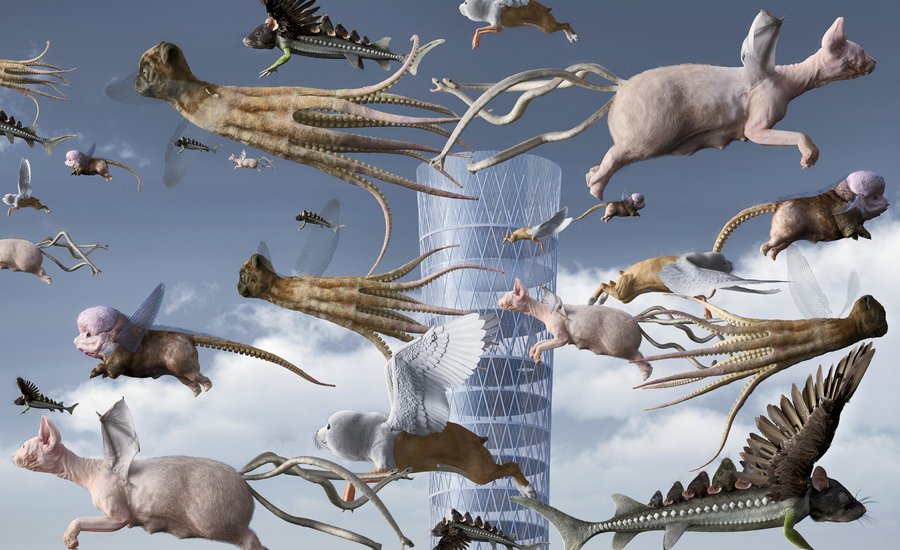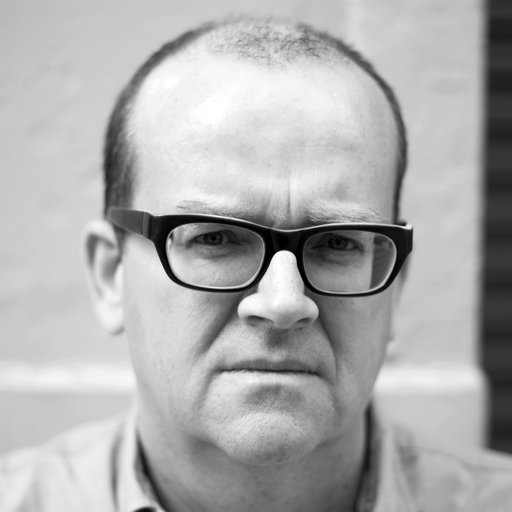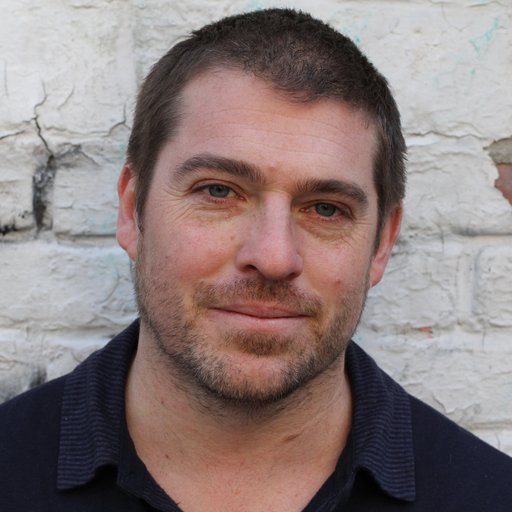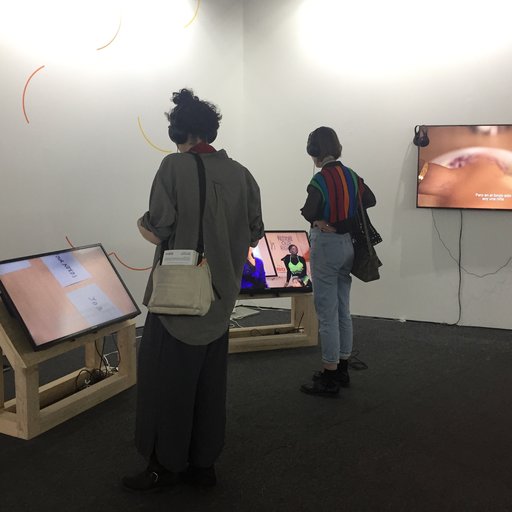NADA New York opened yesterday at its new home in West SoHo's Skylight Clarkson North building, after deciding to move the fair from its usual May slot to March in order to align with the other fairs during Armory Week. The New Dealers Art Alliance (NADA) is known for hosting top-notch galleries representing emerging and mid-career artists—making the fair a great place to discover young talent. Here are ten artists you should definitely keep your eye on.
ATHENA PAPADOPOULOS
The Gangrene Godfather
, 2016
Shoot the Lobster, New York
$10,000
Try keeping your hands off The Gangrene Godfather , the tactilely irresistible fur coat that London-based artist Athena Papadopoulous made in collaboration with Monster Coat Club, a “fur fashion project.” Puffy three-dimensional letters hang from the back of the coat reading “PAPI,” the artist’s nickname, stemming from the her last name. Like the rest of Papadopoulos’s work, the coat encompasses a stitched patchwork of materials like piercings, nail polish, and drawings on leather, some hidden within the lining. While Papadopoulos’s work may appear cute (she uses heart imagery, gold jewelry, and predominantly pink and red tones), it’s hard not to miss their darker undertones. The daughter of a fur trader and notorious womanizer, Papadopoulos grew up surrounded by fur coats—some of which adorned the many woman her dad brought home, and some of which her father made specifically for her to wear. The artist remembers feeling fetishized and on display wearing these sexualized coats at a young age, but simultaneously took comfort in their enveloping warmth and cover.
JOHN EDMONDS
Du-rags
, 2017
ltd los angeles
, Los Angeles
$7,500 each (Editions of 3)
Brooklyn-based Yale graduate John Edmonds made waves last year with his portraits of anonymous men photographed from behind wearing hoodies or hooded jackets. If the pointy white hood of the Ku Klux Klan is a symbol of white supremacy, the hooded sweatshirt has become a symbol of prejudice and racial profiling, and after the fatal police shooting of unarmed black teenager Trayvon Martin, a gesture of solidarity and protest. This year, Edmonds is back at it, photographing anonymous African-American men wearing du-rags. Printed on silk and pinned directly to the wall, Edmonds's images are literally soft, echoing the smooth and satiny feel of an actual du-rag. Edmonds told Artspace that “When I moved to Crown Heights, I began seeing a lot of masculine men wearing du-rags, and was reminded of the du-rags my mom wore while I was growing up...But du-rags aren’t only masculine.” The artist says the popularity of Moonlight can be attributed, in part, to a growing appreciation for what Edmonds calls “soft masculinity,” or “soft masc.” as it’s often referred to online where the concept has been trending.
WILLIE WAYNE SMITH
Have You Seen Me?
, 2017
Good Weather
, Little Rock
$4,000
The large, multilayered paintings of Willie Wayne Smith offer several access points: black line drawings that describe ordinary scenes from the point of view of an anonymous observer, text scribbled with airbrush paint that document the artist’s stream-of-consciousness, and a fragmented picture plane calling to mind a blurry photograph. The hazy, Gerhard Richter-like photorealistic airbrushed layer that in this case, depicts a suburban house, is a return to an earlier style that Smith had employed towards the beginning of his career. For the artist, these images represent memories—not specific points in time per se—but amalgamations of moments that occurred primarily in central Florida. “I grew up in a very religious, conservative, low income-to-middle class area. These memories are coming from that kind of place,” the artist tells Artspace . “It’s exhausting and embarrassing.”
AES+F
Inverso Mundus
, 2017
Mobius Gallery, Romania and TRANSFER, Brooklyn
$175,000-250,000 Euro (Edition of 5 and 2 artist proofs)
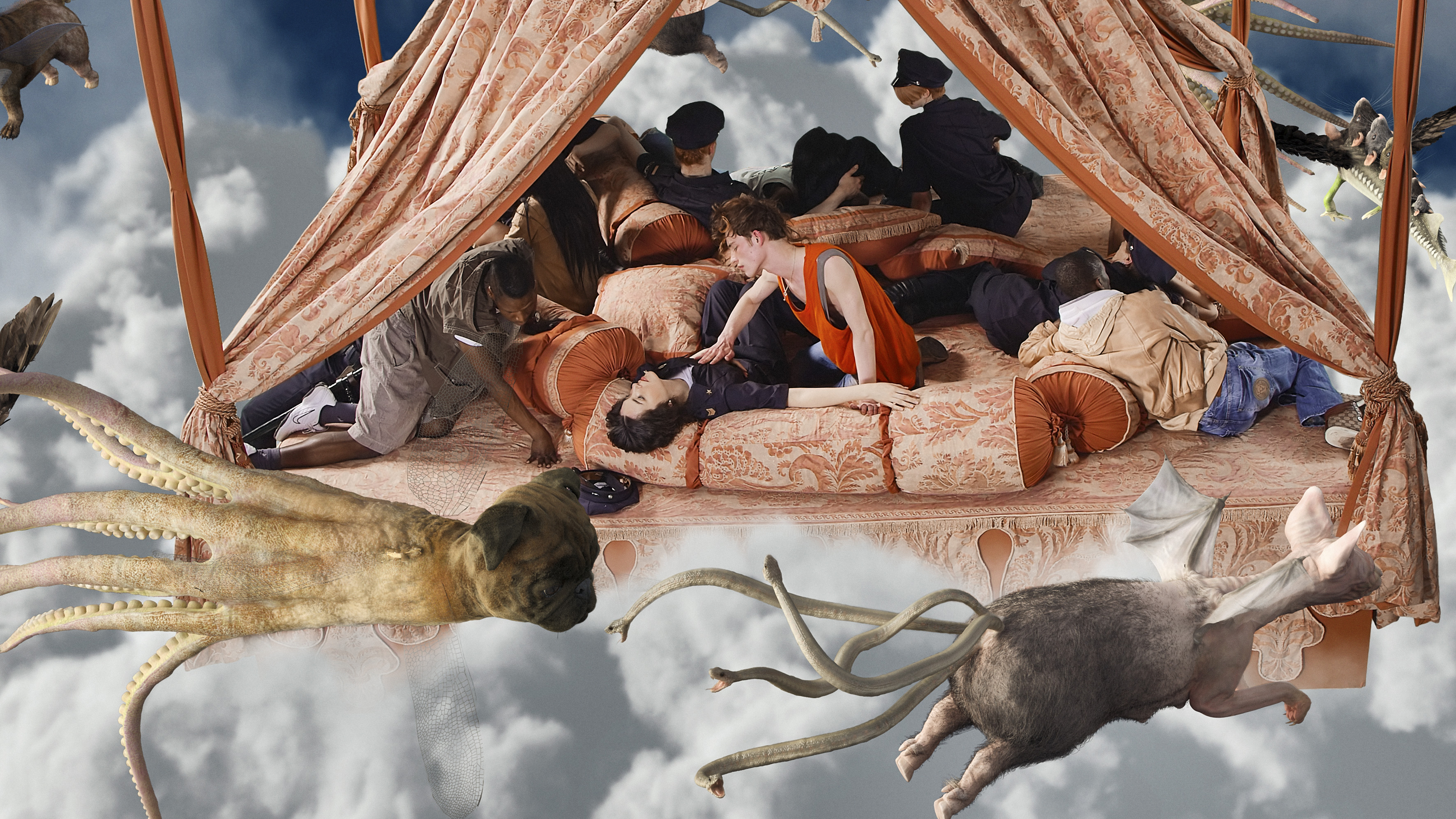
Film and video are largely glossed over during art fairs; one's entrance to a booth generally depends upon a quick glance from the center aisle and durational works demand time that not everyone has to spare amongst art fair's large sprawl of art. But this couldn’t be farther from the case in Mobius Gallery’s booth, which at any given moment during the VIP preview was literally overflowing with people craning their necks to catch a glimpse at AES+F’s 38-minute video, Inverso Mundus , projected wall to wall. Latin for “inverse world,” the title refers to a series of sixteenth-century engravings that depict role reversals: pupils punishing their teachers, a donkey riding a man, or a pig gutting a butcher. In the remake, AES+F—a collective comprised of four Russian-born, New York-based artists—uses unbelievably high-definition collage of recorded and computer-generated moving images. In one slow-motion scene, police officers and civilians caress one another in a bed, at times posing in tableau ; in another, flying chimera have the heads of puppies, tentacles of octopi, wings of a dove, and fish fins. The surrealist video defines a new aesthetic—one that takes equal cues from contemporary fashion advertising and Romantic tableau vivant .
MICHAEL ASSIFF
Hyperaccumulator
, 2017
Motel, Brooklyn
$2,000

Brooklyn-based artist Michael Assiff used his opportunity to present a solo show at NADA to curate a rotating selection of artworks that will be re-hung each day of the fair. The dynamic exhibition addresses “a palpable inflation of injustices—committed against humans, animals, and ecologies—in the wake of both a personally and collectively traumatic 2016.” In addition to works by Joe Girandola, Frankie Friday, and Harry Gould Harvey, the booth displays several new paintings by Assiff in his signature style: particular species of plants that are able to pull toxins out of the soil rendered in plastic and adhered to muslin. In Hyperaccumulator , Assiff also printed the signature of the artist who creates Chipotle’s branded “artwork” on the canvas, which can be seen in slivers through the latticework of stems and leaves. The artist is known for his beautiful yet conceptually critical works that point to injustices in industries related to the environment.
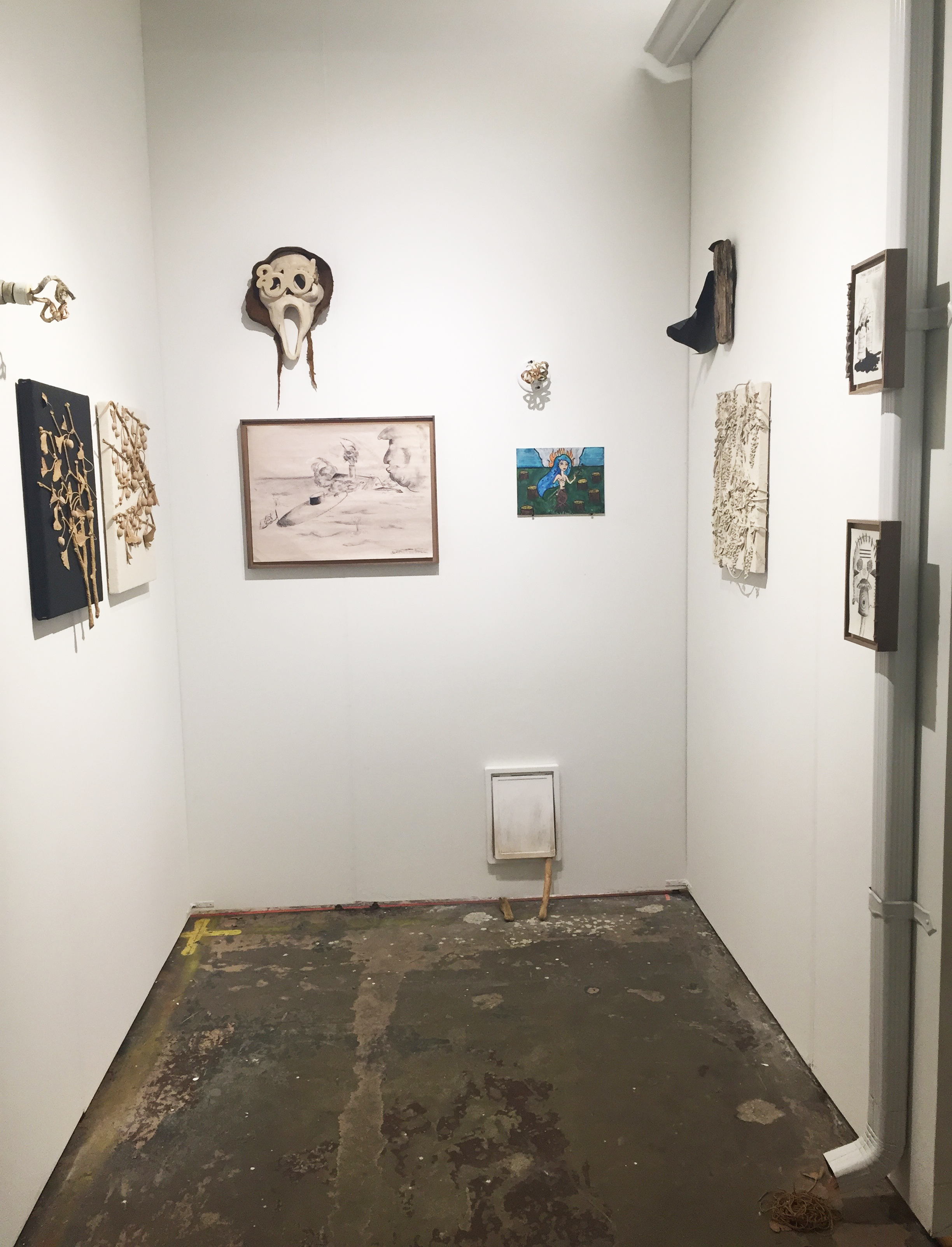
SYDNEY SHEN
Bread Clock
, 2017]
Roberta Pelan, Toronto
This piece is exactly what it looks like it is: bread (yes, actual bread) inside of plastic takeout containers, turned into clocks. Time is money, and money is “bread,” right? Beyond the word play, Shen’s work mixes steam punk (a stylistic movement that is purely aesthetic yet inspired by steam technology) and the Industrial Age, which introduced a unified railroad system and initiated the concept of standardized time. Shen’s solo booth has recurring train motifs; on the outside wall hangs a piece made to look like the “Poetry in Motion” poems that are bolted to the walls of subway cars in New York. In her remake, Shen prints a poem about cheese—an actual poem attributed to Virgil (though the actual author is unknown) that had one of the first uses of the phrase “ e pluribus unum. ” Translating to “out of one, many,” the U.S. slogan was originally used to describe the blending of colors during the process of making an herb and cheese spread akin to modern pesto. It goes without saying that Shen’s work has a sense of humor.
BRIDGET MULLEN
We Break Symbolic
, 2016
Hometown, Brooklyn
Price undisclosed
Bridget Mullen’s paintings are hard not to like. Repeating figures—some based on iconic characters like the Smurfs—become abstract on patterned backgrounds. The artist often works on paper, building up layers of acrylic paint before settling on a surface—the textured evidence of which is palpable. Hometown director Adam Yokell describes Mullen as “somewhat nomadic” having spent the last several years hopping from residency to residency. In 2016 she went to the prestigious Skowhegan School of Painting and Sculpture, and the year before that she honed her craft at the Fine Arts Work Center in Provincetown, Massachusetts. If you’re anxious to see more of her work, you’ll need to wait until next month when Hometown will present the artist’s work in a two-person show with Antone Könst .
ZACH NADER
Doubt Every Word
, 2017
Microscope, Brooklyn
$4,000
Online advertisements have become so ubiquitous that we hardly notice them anymore, despite their being customized and tailored to our personal browsing habits. For artist Zach Nader, these ads become departure points for a creative method that first involves removing all products and people using editing software like Photoshop—leaving only the advertisement’s background. Once edited, Nader photographs the screen of his computer, capturing fingerprints, smudges, and vibrating pixels in the process. “The words are situated in the screen, which is where we’re always seeing things now anyways,” says Nader’s dealer. “The artist produces new content out of what had been disposable imagery.”
FRED LONIDIER
Sanitary
, 1997
Michael Benevento, Los Angeles
$6,500 (Edition of 3)
Though it’s not quite fair to call Fred Lonidier a “rising star” (born in 1942, Lonidier showed at the Whitney in 1977), the political artist feels more relevant now than ever. Sanitary comes from a series of works that cover fifteen years of the North American Free Trade Agreement (NAFTA), which according to the artist, is motivated by a “race to the bottom” that threatens wages, working conditions, and trade unions. Beginning in the mid-1990s, Lonidier’s “N.A.F.T.A. (Not A Fair Trade for All)” series represents “some of the troubling conditions of Mexicans who work in the maquiladoras,” or Mexican factories along the U.S. border that are owned by U.S. companies. Now that the U.S.’s current administration threats to disrupt trade with Mexico and tweak the trade agreement, NAFTA has come under scrutiny.
ROSE MARCUS
Imagine (other, field)
and
Imagine (other, field II),
2017
David Peterson, Minneapolis
Around $10,000 each
Several works by Rose Marcus graced the booths of at least three different galleries at NADA this year. At Minneapolis’s David Peterson, two large inkjet prints on clear adhesive vinyl mounted to tempered glass were installed on the back wall, which is visible through the works’ transparent highlights. Transparency is a recurring theme in Marcus’s work: these particular pieces were made by photographing the John Lennon Strawberry Fields memorial in New York with another transparent photograph held in front of the camera, creating the illusion of a warped double exposure. Lennon’s memorial is one of several New York City landmarks (including the Empire State Building and Central Park) that the artist documents—capturing impersonal moments in motion in an otherwise timeless, memorializing public space.











